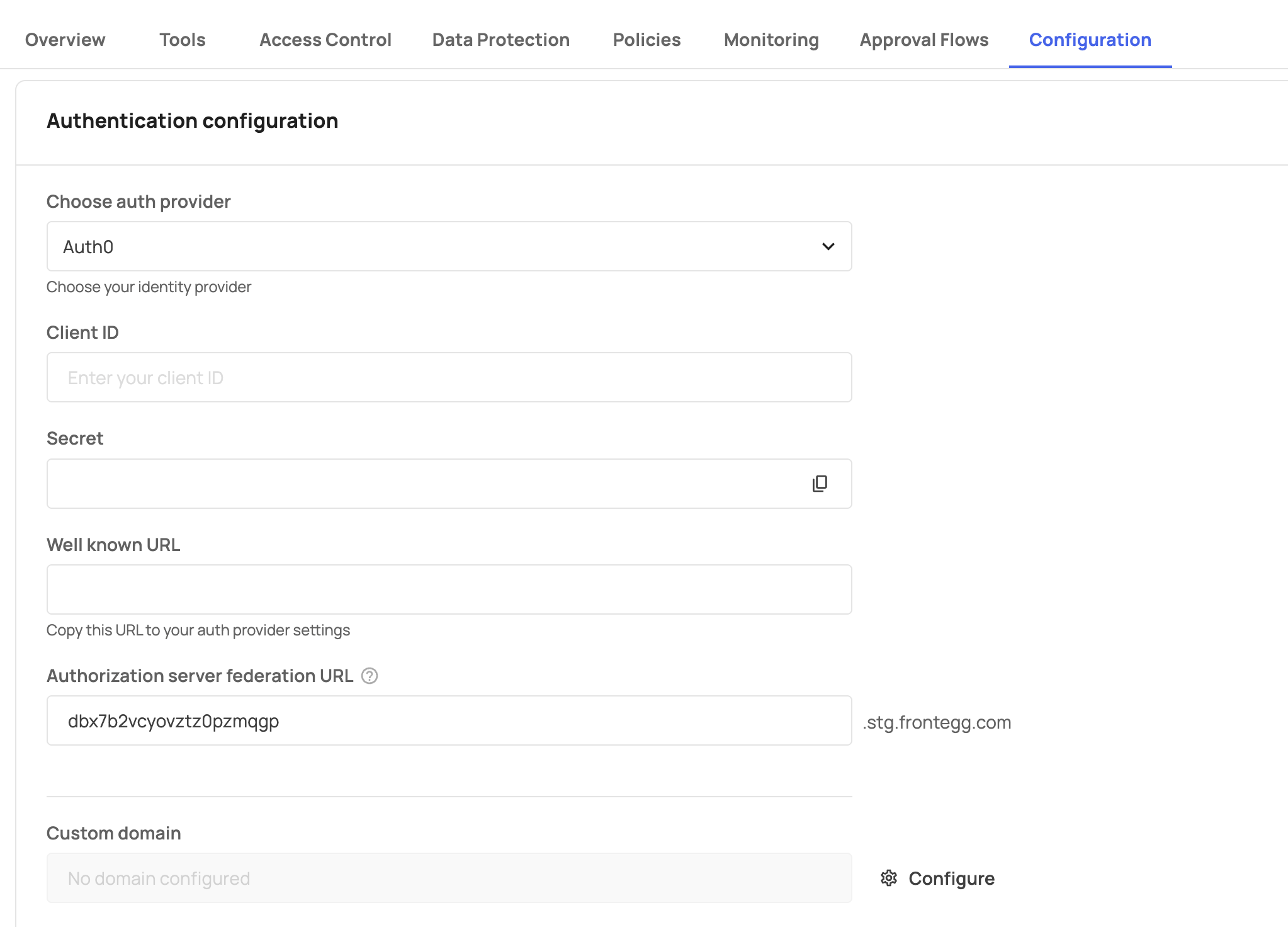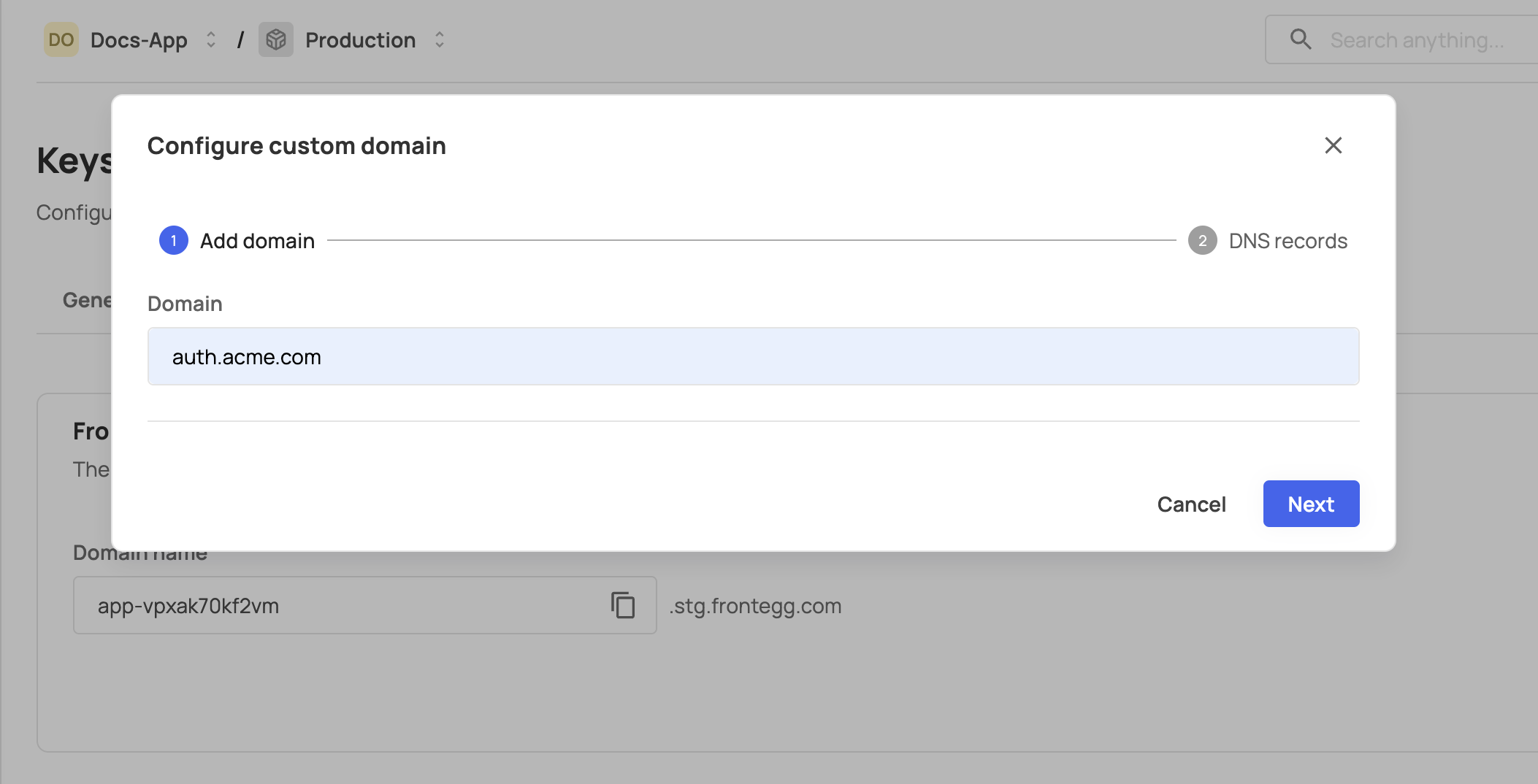Configure custom domains for your agent-ready applications to provide a branded experience for both authentication and MCP gateway access.
Frontegg allows you to configure custom domains in two key areas of your agent application:
- Authentication Domain - Used for your authorization server federation URL and login flows
- MCP Gateway Domain - Used for your MCP gateway URL endpoint
Custom domains help you maintain brand consistency and provide a professional experience for your users.
Before configuring custom domains, ensure you have:
- Domain ownership and administrative access
- DNS management access for your domain
The authentication custom domain is used for your authorization server federation URL and all authentication-related endpoints.
To configure a custom domain for authentication, open the Frontegg portal and navigate to [Portal] → [Configuration] → [Authentication configuration].

In the Authentication configuration section, locate the Custom domain field and click on Configure. In the popup dialog box, insert your desired domain name to generate the CNAME record you need for your DNS configuration.

Best practice
Best practice
A common practice is to use a subdomain as the custom domain. For example, if your app is hosted on app.sample.com and you have an existing A record for that domain, you cannot use app.sample.com as a custom domain on Frontegg. Instead, use a subdomain as the custom domain, like auth.sample.com.
After adding the CNAME to your DNS configuration, click the Verify button. If Frontegg is able to verify the CNAME record, you will see a success message. After a successful setup, you should also see your custom domain listed with a verified tag. Domain verification typically takes anywhere from a few minutes to a few hours.
If you see a notification that Frontegg is unable to verify your custom domain, please double-check that you entered your CNAME correctly in your DNS provider and try again.

A CNAME does not exist error may appear if your domain failed validation, possibly due to a Certificate Authority Authorization (CAA) issue. This can usually be resolved by adding the appropriate CAA record to your DNS settings.
Once configured, your authentication domain will be used for:
- Authorization server federation URL: Previously
[subdomain].frontegg.com, now becomesauth.yourdomain.com - Login and authentication flows
- OAuth/OIDC endpoints
- User authentication sessions
If no custom domain is configured, the system displays "No domain configured" and uses the default Frontegg domain structure: [subdomain].frontegg.com
The MCP gateway custom domain is used for your Model Context Protocol gateway endpoint, which handles agent communication and tool execution.
To configure a custom domain for your MCP gateway, open the Frontegg portal and navigate to [Portal] → [Settings] → [Basic Configuration].

In the Basic configuration section, you'll see the MCP gateway URL field displaying your subdomain prefix (e.g., dbx7b2vcyovztz0pzmqgp) followed by .mcp-gw.frontegg.com.
Below this, in the Custom domain section, click on Configure. In the popup dialog box, insert your desired domain name to generate the CNAME record you need for your DNS configuration.

Best practice
Best practice
Use a dedicated subdomain for your MCP gateway, such as mcp.sample.com or gateway.sample.com, to keep it separate from your authentication domain and maintain a clear separation of concerns.
After adding the CNAME to your DNS configuration, click the Verify button. If Frontegg is able to verify the CNAME record, you will see a success message. After a successful setup, you should also see your custom domain listed with a verified tag. Domain verification typically takes anywhere from a few minutes to a few hours.
If you see a notification that Frontegg is unable to verify your custom domain, please double-check that you entered your CNAME correctly in your DNS provider and try again.

A CNAME does not exist error may appear if your domain failed validation, possibly due to a Certificate Authority Authorization (CAA) issue. This can usually be resolved by adding the appropriate CAA record to your DNS settings.
Once configured, your MCP gateway domain will be used for:
- Agent communication endpoints
- Tool execution requests
- MCP protocol interactions
- Integration callbacks
If no custom domain is configured, the system displays "No domain configured" and uses the default MCP gateway structure: [subdomain].mcp-gw.frontegg.com
DNS changes typically propagate within a few minutes to a few hours, though in rare cases it can take up to 24 hours. Frontegg will automatically provision SSL certificates once DNS is verified.
You can verify DNS resolution using command-line tools:
# Verify DNS resolution
dig auth.yourdomain.com CNAME
nslookup auth.yourdomain.com- After DNS propagation, test your authentication domain:
curl https://auth.yourdomain.com/.well-known/openid-configuration - Verify that the authorization endpoints return the expected configuration
- Test your MCP gateway endpoint:
curl https://mcp.yourdomain.com/health - Ensure your agent applications can connect to the custom domain
- Use Subdomains: Use dedicated subdomains (e.g.,
auth.andmcp.) rather than root domains - Plan for Both: Configure both authentication and MCP gateway domains for a consistent branded experience
- Test Before Production: Verify both domains in a staging environment before updating production applications
- Monitor DNS: Keep track of DNS record expiration and renewal dates
- Document Changes: Maintain documentation of your custom domain configuration for your team
- SSL/TLS: Frontegg automatically manages SSL certificates, but ensure your domain supports HTTPS
Issue: Custom domain verification fails after adding DNS records
Solutions:
- Wait longer for DNS propagation (up to 24 hours in rare cases)
- Verify CNAME record is correctly pointing to the Frontegg hostname
- Check for conflicting A or CNAME records
- Ensure there are no DNS caching issues:
dig +trace auth.yourdomain.com
Issue: SSL certificate warnings when accessing custom domain
Solutions:
- Allow time for Frontegg to provision the SSL certificate (up to 1 hour after verification)
- Verify DNS records are correctly configured
- Clear browser cache and try again
- Contact Frontegg support if issues persist after 24 hours
Issue: Agents cannot connect to custom MCP gateway domain
Solutions:
- Verify the MCP gateway URL in your application configuration
- Test connectivity:
curl https://mcp.yourdomain.com/health - Check firewall rules allow outbound connections to the custom domain
- Verify API base URL and MCP gateway URL are both correctly configured
- HTTPS Only: All custom domains must use HTTPS (enforced by Frontegg)
- Certificate Management: Frontegg automatically provisions and renews SSL/TLS certificates using Let's Encrypt
- Domain Validation: Only verified domains can be used for authentication and MCP gateway endpoints
- Configure authentication settings with your custom domain
- Set up backend verification for secure token validation
- Learn about agent applications